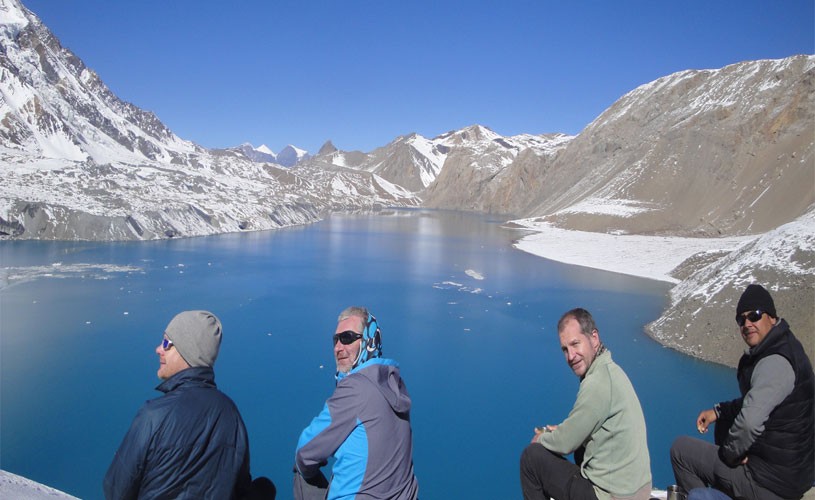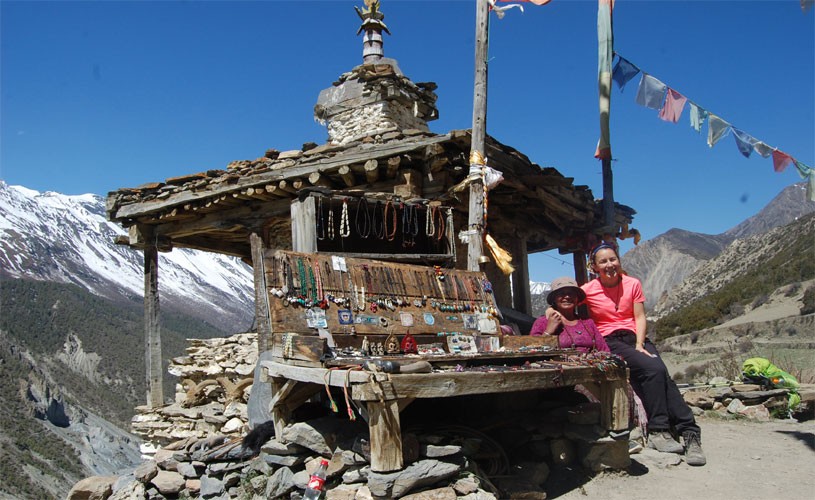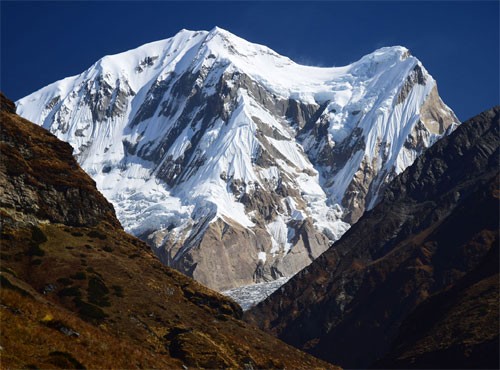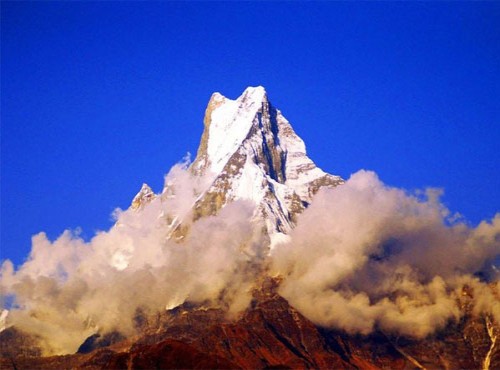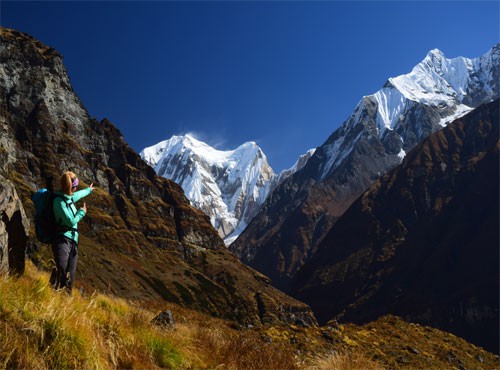Key Highlights of the Annapurna-Tilicho Lake Trek
- Thorong La Pass is located at 5,416 meters.
- Tilicho Lake (4,949 m) is one of the highest in the world.
- Blue sheep at Yak Kharka
- Views of Mt. Annapurna, Thorung Peak, Nilgiri, and Chulu West and East.
- Magnificent glaciers, lakes, gorges and waterfalls
- Muktinath is a holy site for both Hindu Buddhists.
- Manang district: Embrace its beauty
- Barge Monastery is the largest monastery in the Manang district.
Annapurna Circuit with Tilicho Lake Trek Overview:
The Annapurna Circuit With Tilicho Lake Trek is among the best in the Annapurna area. It offers opportunities to experience Himalayan flora and fauna, holy monasteries and temples, breathtaking waterfalls, diverse climate regions, diverse cultures, high passes, and deep gorges.
Experience the beautiful sights of mountains, fields, and villages as you journey from Kathmandu to Beshishar and Dharapani early in the morning. The Annapurna Circuit With Tilicho Lake trek starts from Beshisahar and ends in Pokhara. On the first day, we'll walk from Dharapani to Chame (2610 m/8,890 ft), the area's main town. You'll get to see the Annapurnas II and III and Lamjung Himal. After staying overnight in Chame, we'll trek to Upper Pisang (3,115 m/10,200 ft), passing by a trail where we can view the Paungda Danda Rock Face.
From Pisang, we trek to Manang, 3,540 m/11,300 ft. You will pass Tibetan settlements and giant peaks such as Gangapurna, Tilicho, and Pisang Peak. Spend a day acclimatizing in Manang, and the next day, head to Siri Kharka (4,060 m/13,320 ft).
You will spend the night at Tilicho base camp (4,150 m/13,583 ft). The following day will be a unique experience as you reach the majestic Tilicho Lake. From Tilicho Lake, you can see the most beautiful snow-capped mountains and pristine water. The experience is unparalleled anywhere else in the world. The Annapurna Range and Nilgiri Himal surround Tilicho Lake as if it is a treasure trove of nature. You will spend the night in Siri Kharka after reaching Tilicho Lake.
You will start your trek the next morning from Siri Kharka to Yak Kharka, the destination of this day. Yak Kharka has blue sheep and, if lucky, a snow leopard. On the eleventh day, you will arrive at Thorong Phedi, a small settlement ideally situated for a successful Thorong La Hi-Pass crossing (5,416 m/17,756 ft). If the conditions are good at Thorong Phedi, we may trek to High Camp.
We wake up at Thorong Phedi early to prepare for the Thorong La Hi-Pass. We then push through the high-altitude fatigue and icy air to cross the Thorong La Pass. From the Thorong La Pass, the Himalayas stretch northwards to Tibet and the Annapurna Mountains to the south. You will then walk down to Muktinath, a sacred place for Buddhists and Hindus. We will stay the night in Muktinath because you will be tired.
Kagbeni is another popular destination in Lower Mustang, Nepal. It is a place that is enchanting with its ancient charm and breathtaking scenery. This remote village, perched at 2,800 meters, is steeped in Tibetan Buddhist culture. The labyrinthine street winding through the town is lined with traditional mud-brick houses decorated with prayer flags that flutter in the Himalayan winds. Kagbeni, a tranquil retreat for spiritual seekers and trekkers alike, is surrounded by majestic snow-capped mountains and the mystical Kali Gandaki River.
The Annapurna Circuit Trek will conclude in Kathmandu on the final day. You will return to Pokhara by plane from Jomsom and then take a tourist coach to Kathmandu. By then, you'll have gained valuable experiences on the trek. Your determination to succeed will also influence your thinking for many years.
This package includes transportation from Kathmandu to Banisher via private car or van (depending on group size), followed by a public jeep ride to Dhaprapani. Additionally, you have the option to fly from Jomsom to Pokhara. If you want to upgrade your transportation from Pokhara to Kathmandu by flight, we will arrange it at an additional cost.How Difficult is Annapurna Circuit With the Tilicho Lake Trek?
The Annapurna Circuit with the Tilicho Lake Trek is considered moderately complex. Spanning approximately 200 kilometers, it typically takes around 14 to 16 days to complete. Trekkers encounter diverse terrain, from lush forests to high mountain passes, reaching altitudes over 5,000 meters. Challenges include acclimatization to high altitude, variable weather conditions, and extended daily treks. However, the stunning scenery, cultural immersion in local villages, and the chance to witness breathtaking views of the Himalayas make it a rewarding adventure. Proper preparation, including physical fitness training and acclimatization, is essential for a safe and enjoyable experience.
When is the Best Time for the Annapurna Circuit Tilicho Lake Trek?
The best time for the Annapurna Circuit Trek is spring and autumn in Nepal. Spring/pre-monsoon weather is dry and moderate during February, March, April, and May. The Annapurna region is best suited for trekking during spring when the mountains are visible and the scenery is beautiful. The temperature can range from 18 to 23 degrees Celsius during the day and drop to -8/12 degrees Celsius overnight.
The autumn (post-monsoon) season is also a great time to adventure along the Annapurna circuit route. This season occurs in September, October, November, and December. The temperatures in autumn range between 12 and 20 degrees Celsius during the day and -5/10 degrees Celsius at night. It is cooler, and it is a good time to go trekking.
Accommodation during the Annapurna Circuit with Tilicho Lake Trek
The accommodation on the Annapurna Circuit is in teahouses and trekking guesthouses. Rooms are neat and clean, with a double occupancy capacity; the beds are made of wood and soft mattresses, pillows, and warm blankets. Some rooms have attached bathrooms (not everywhere). You will enjoy a comfortable and relaxing sleep in cozy rooms. Single rooms are available for female solo travelers (except Himalaya and ABC). But it might be hard to get one during the busy times when many tourists are around. During your trek, you will be accommodated in the best teahouse with a great view of the mountains and scenery.
Meals during the Annapurna Circuit with Tilicho Lake Trek
The Annapurna Trek with Tilicho Lake takes place in high altitudes, near some of the highest peaks on Earth. You will, therefore, need to eat nutritious food. You will receive a nutritious and hygienic meal throughout your journey. The options for meals are more limited than in cities. We will provide 16 breakfasts, 15 lunches, and 14 dinners during the trek.
We choose lodges with fresh, nutritious, hygienic, and tasty food. As we move up, the menu becomes shorter. Try the famous Nepali food, including Dal (lentils), Bhat (rice), Tarkari (curry), Momo (dumplings), and Chow Mein noodles. We recommend plenty of fresh vegetables, green tea, lemon and ginger teas, garlic soup, and hot lemon and ginger tea at high altitudes. We do not recommend non-vegetarian items, even though they are available in trek areas.
Drinking water during the Annapurna Circuit with Tilicho Lake Trek
Adventure Club provides all the meals on the trek but needs to provide water. The best option is to treat the local water with chlorine/iodine tablets or a SteriPen. The teahouses will give you good-quality free water, and you can also get it along the trail, but you will need to treat it. If you use the tablets, make sure they dissolve completely (about 30 mins). On most treks, you can buy mineral water along the trail. A liter of mineral water at lower-elevation tea houses costs around USD 1. However, higher elevations can cost up to $4, so the cost can add up.
Electricity, WIFI, And Battery Recharge
During the trek, electricity is available at all the teahouses where you will spend the night. You can recharge your phones, laptops, or iPads from micro-hydropower and solar panels by paying a nominal charge. Regarding Wi-Fi, there are no free hotspots along the trekking trail, so we do not encourage carrying your laptop. Some teahouses offer paid Wi-Fi services hourly, but don’t expect high-speed connectivity on the remote trails.

